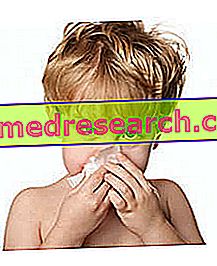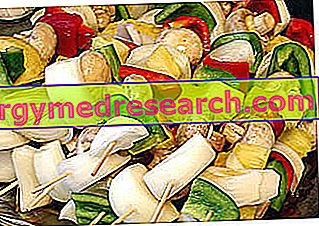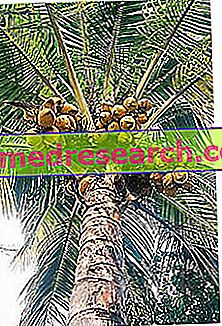Definition of phenous fever
The term "hay fever" refers to an allergic rhinitis due to pollinosis: it is a very common allergy, which tends to recur seasonally or periodically in sensitive subjects. Hay fever affects the nasal mucosa, eyes and respiratory tract, and is caused mainly by pollen; some individuals show allergies even after contact with dust, feline hair and other possible irritants.

Incidence
It is clear that, being an allergic rhinitis generated by pollens, hay fever tends to become acute in the spring, near flowering parks and countryside. Regardless of the seasonality of allergy, it has been shown that hay fever can also be influenced by strong emotional stress and excessive intake of alcohol.
More than 20 different types of hay fever have been identified, triggered by more than 3, 500 plants: the most "dangerous" are birch, ash and grasses in general.
Symptoms
Typical symptoms of hay fever are continuous sneezing, nasal itching, red eyes and the constant sensation of a stuffy nose, often due to rhinorrhea (abundant nasal aqueous secretion); one of the most common symptoms is also the breathing difficulty, mainly caused by rhinorrhea.
Furthermore, hay fever can also generate an annoying itch on the palate, eyes and, more rarely, in the ears.
It is very frequent that the typical signs of allergy are also associated with headaches and general fatigue, symptoms even more marked in those subjects suffering from chronic forms of hay fever, with exacerbations repeated during the year regardless of the presence of pollen or of irritants.
The most problematic symptoms of hay fever are edema and congestion of the nasal mucous membranes: for these reasons, the subject is unable to breathe through the nose, since the nostrils are obstructed by the mucus and the passage of oxygen is denied .
Sometimes, hay fever also causes pharyngitis and conjunctivitis; in some subjects, continuous sneezing and nasal congestion induce stress, so as to generate a certain nervous irritability. When hay fever is also related to inflammatory processes in the bronchial mucosa, the conditions of the affected subject could degenerate, to the point of developing a real asthmatic crisis.
Biochemical causes
The pollen proteins represent the main defendants responsible for hay fever: as they are allergens, the first time they come into contact with a sensitive organism, they induce the production of antibodies. Subsequently, in the event of a new contact between allergen and organism, the pollen proteins are perceived more quickly as potentially dangerous (sensitization), therefore the organism responds with more or less intense allergic phenomena, based on the sensitivity and reactivity of the subject.
In allergic subjects, continuous sneezing is mainly due to the release of histamine, operated by mast cells: histamine pours onto receptors, triggering a vicious circle that inevitably generates sneezing, nasal itching and edema.
Diagnosis
Three common procedures are needed to diagnose hay fever; medical history, physical examination and laboratory tests. The patient's medical history is based on the collection of information relating to the symptoms he complains of, followed by the search for a possible allergy familiarity to investigate the genetic predisposition. The objective examination consists in the investigation of the common and classic symptoms of hypothesized allergopathy; while laboratory tests - including blood analysis and research on type E immunoglobulins - are a further confirmation of hay fever, which is not always essential.
Again, to complete the diagnostic picture, we recommend the RAST-test, the RAST-like, the intradermal tests and the prick-test, useful for isolating the allergen, then for implementing a seasonal prophylaxis plan.
Care
The administration of antihistamine drugs, which hinder the histamine action, reduce the symptoms generated by hay fever; also the use of decongestants and substances with a vasoconstrictor action can be very useful.
In allergic and asthmatic patients, in whom the symptoms appear particularly intense, the doctor generally prescribes corticosteroids, able to exert a strong anti-inflammatory action, therefore to calm the allergic symptoms and asthma in a short time.
When the allergen responsible for the hay allergic reaction is isolated, a desensitization operation is possible: it is an immuno-therapeutic approach which consists in the administration of specific doses of the allergen itself, subcutaneously. In doing so, the immune system is gradually accustomed to the presence of the antigen, as a sort of addiction to the allergen . This therapy, unfortunately, does not prove useful in all patients, since each subject reacts in a proper way to the cure.
Another alternative therapy comes from the medical school of Sapporo (Japan): hay fever seems to react positively to the inoculation of vitamin E, thanks to its supposed antihistamine properties. In fact, tocopherol seems to reduce the pressure, torpor and some typical symptoms of hay fever. However, this alternative therapy for treating hay fever has yet to be effectively demonstrated.
Summary
Hay fever: in short
| Hay fever | Allergic rhinitis due to pollinosis: very common allergy, tending to recur seasonally or periodically in sensitive subjects |
| Hay fever: causes | Pollen contact / inhalation, feline hair, dust, irritants. Possible correlation between pollinosis, excessive alcohol intake and stress |
| Hay fever: incidence | Hay fever tends to get worse in spring, near parks or countryside |
| Hay fever: symptomatology |
|
| Hay fever: the biochemical explanation | Allergens = antigens = pollen proteins: profilins, reserve proteins, pathogenesis related proteins etc. Contact with the allergen → Mast cell activation → histamine release → sneezing, nasal itching, edema |
| Hay fever: diagnosis |
|
| Hay fever: therapies |
|



